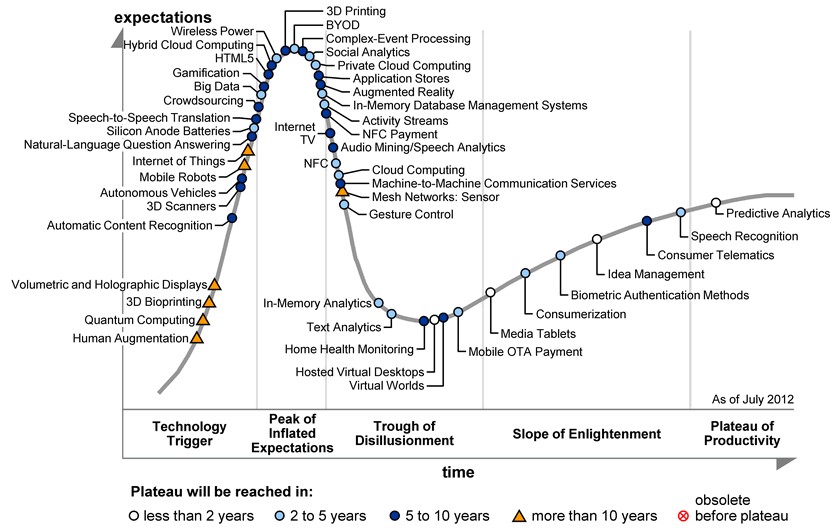The Problems with Gamification in Gartner’s Hype Cycle
Gamification has finally hit a significant speed bump—overinflation from hype and expectations. In a recently published Gartner article, in-house analysts have predicted that about 80% of gamified solutions will fail in reaching business objectives by 2014 due to poor design. This could be easily avoided if people would simply just use good gamification design, but that simply isn’t the case.
The ‘g’ term reached a peak volume of 100 (according to Sept 2012 in Google Trends, compared to Sept 2010 search volume of 3). It is fascinating to see how quickly gamification has blown up in popularity, but with great power comes great responsibility. No longer can gamification be strongly associated to just points, badges, and leaderboards. Rather, basic gamification frameworks require meaning and objectives towards progress, collaboration, and innovation.
So what’s the problem? We view Gartner’s Hype Cycle to diagnose where gamification is and where it can head with proper design. Below is Gartner’s Hype cycle:
Listed on the hype cycle are other technologies that are subject to the five stages of hype: technology trigger, peak of inflated expectations, trough of disillusionment, slope of enlightenment, and plateau of productivity—aka mainstream adoption.
Over the course of the past couple months, gamification was in the technology trigger phase. Successful implementations such as Nike+ and Coursera’s gamification course sparked global interest. The mass movement paved the way for SaaS companies such as Badgeville, Bunchball, and BigDoor to offer gamification platforms to third party’s existing apps. However, this initial success has given the misconception that gamification always works and that all it needs is throwing badges for every customer action.
This over inflation has lead gamification to the peak of inflated expectations. Many people now just think that game elements added to any service or product will automatically engage customers in cohesive ways. The truth is that people are getting fatigued with having all of their actions earn them points for separate accounts, badges for menial tasks, and rankings on a leaderboards with no implicit meaning. Gartner research Brian Burke stated, “Companies and developers get too fixated on bells and whistles like points and badges, while not creating meaningful enough motivations and objectives. Without the latter, the former become meaningless.”
With that said, gamification is unfortunately heading to the third phase of any technology hype: the trough of disillusionment. Currently, for every successful app like Nike+, there will be 7 or 8 unsuccessful attempts. This is a sensitive time as people could become discouraged from using game elements to spark productivity, innovation, and collaboration. However, take a look the video game market, and you will see that games are well and alive. Just recently, Black Ops 2 (the popular first person shooter) reached $1bn of sales in about 2 weeks of its release.
The reason gamification is not enjoying successful times for every developer and company is that people are worrying too much about the rewards, incentives, and loyalty programs. What this equates to is just people are worried about metrics, numbers, and more numbers. Complete a sale, get 10 points. Order the special buffalo wings special, get 20 points. Send out 15 emails to your team, get a badge. In the most basic essence, these are just sprinkles on ice cream. The cream that successful gamification derives itself from is being able to incorporate these points and metrics to meaningful objectives and progress to each user.
To ensure that gamification will not crash and burn in the trough of disillusionment, developers need to heed certain advice when designing gamified solutions for customers or for enterprise.
On the path to the slope of enlightenment and finally the plateau of productivity, every developer should heed to the advice of designing for progress, collaboration, and innovation. Progress is not just assigning levels after a user has completed set objectives. Progress should be designed in the form of “congratulations John Doe! Your successful completion of certain objectives marks you as an expert in [insert topic here]. With being an expert, here are [insert intrinsic or extrinsic prizes]”. People want to be awarded for their work, but they want to also see visible measures of their personal growth. Collaboration is designing certain game elements centered on teamwork. Enterprises are always interested in finding efficient ways to getting people to work together; so collaborative elements would integrate smoothly with progress (ex. “congratulations John Doe(s), your teamwork has contributed to x amount of profit for the company. As a reward, you are given the ‘team leader’ badge which gives you the ability to take upon projects and mentor other employees”). Lastly, innovation should come in the form of open-ended games. Innovative game elements provide clear set of rules and objectives but not a clear path for how to achieve the objectives. This allows for creativity in the workplace, and every user of a gamified app wants to showcase their personal problem-solving prowess.
According to Gartner, enterprises have become some of the biggest adopters of gamification techniques. It is predicted that by 2015, about 40% of Global 1000 organizations will use gamified elements in their IT to get employees to be more productive. These predictions make it that much more imperative that gamification needs to be designed properly with the intent to incorporate meaningful objectives rather than aesthetics like points, badges, and leaderboards.
via TechCrunch










[…] Following Gamification Through Gartner’s Hype Cycle | Gamification Co The problems with #gamification in Gartner’s cycle, RT @rmreese1: Following Gamification Through Gartner’s Hype Cycle: http://t.co/NcxpLEpQ […]